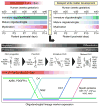Neurobiology of premature brain injury
- PMID: 24569830
- PMCID: PMC4106480
- DOI: 10.1038/nn.3604
Neurobiology of premature brain injury
Abstract
Every year in the United States, an estimated 500,000 babies are born preterm (before 37 completed weeks of gestation), and this number is rising, along with the recognition of brain injuries due to preterm delivery. A common underlying pathogenesis appears to be perinatal hypoxia induced by immature lung development, which causes injury to vulnerable neurons and glia. Abnormal growth and maturation of susceptible cell types, particularly neurons and oligodendrocytes, in preterm babies with very low birth weight is associated with decreased cerebral and cerebellar volumes and increases in cerebral ventricular size. Here we reconcile these observations with recent studies using models of perinatal hypoxia that show perturbations in the maturation and function of interneurons, oligodendrocytes and astroglia. Together, these findings suggest that the global mechanism by which perinatal hypoxia alters development is through a delay in maturation of affected cell types, including astroglia, oligodendroglia and neurons.
Conflict of interest statement
The authors declare no competing financial interests.
Figures


Similar articles
-
Perinatal brain injury in the preterm and term newborn.Curr Opin Neurol. 2002 Apr;15(2):151-7. doi: 10.1097/00019052-200204000-00005. Curr Opin Neurol. 2002. PMID: 11923628 Review.
-
The developing oligodendrocyte: key cellular target in brain injury in the premature infant.Int J Dev Neurosci. 2011 Jun;29(4):423-40. doi: 10.1016/j.ijdevneu.2011.02.012. Epub 2011 Mar 5. Int J Dev Neurosci. 2011. PMID: 21382469 Free PMC article. Review.
-
Cerebral white and gray matter injury in newborns: new insights into pathophysiology and management.Clin Perinatol. 2014 Mar;41(1):1-24. doi: 10.1016/j.clp.2013.11.001. Clin Perinatol. 2014. PMID: 24524444 Free PMC article. Review.
-
The encephalopathy of prematurity--brain injury and impaired brain development inextricably intertwined.Semin Pediatr Neurol. 2009 Dec;16(4):167-78. doi: 10.1016/j.spen.2009.09.005. Semin Pediatr Neurol. 2009. PMID: 19945651 Free PMC article. Review.
-
Brain Injury in the Preterm Infant: New Horizons for Pathogenesis and Prevention.Pediatr Neurol. 2015 Sep;53(3):185-92. doi: 10.1016/j.pediatrneurol.2015.04.006. Epub 2015 Apr 18. Pediatr Neurol. 2015. PMID: 26302698 Free PMC article. Review.
Cited by
-
Recent advancements in diffusion MRI for investigating cortical development after preterm birth-potential and pitfalls.Front Hum Neurosci. 2015 Jan 21;8:1066. doi: 10.3389/fnhum.2014.01066. eCollection 2014. Front Hum Neurosci. 2015. PMID: 25653607 Free PMC article. Review.
-
The Role of Oxidative Stress in the Progression of Secondary Brain Injury Following Germinal Matrix Hemorrhage.Transl Stroke Res. 2024 Jun;15(3):647-658. doi: 10.1007/s12975-023-01147-3. Epub 2023 Mar 17. Transl Stroke Res. 2024. PMID: 36930383 Review.
-
Alteration of the Oligodendrocyte Lineage Varies According to the Systemic Inflammatory Stimulus in Animal Models That Mimic the Encephalopathy of Prematurity.Front Physiol. 2022 Jul 19;13:881674. doi: 10.3389/fphys.2022.881674. eCollection 2022. Front Physiol. 2022. PMID: 35928559 Free PMC article. Review.
-
The Potential of Stem Cell Therapy to Repair White Matter Injury in Preterm Infants: Lessons Learned From Experimental Models.Front Physiol. 2019 May 9;10:540. doi: 10.3389/fphys.2019.00540. eCollection 2019. Front Physiol. 2019. PMID: 31143126 Free PMC article. Review.
-
Evidence Implicating Non-Dioxin-Like Congeners as the Key Mediators of Polychlorinated Biphenyl (PCB) Developmental Neurotoxicity.Int J Mol Sci. 2020 Feb 4;21(3):1013. doi: 10.3390/ijms21031013. Int J Mol Sci. 2020. PMID: 32033061 Free PMC article. Review.
References
-
- Anderson P, Doyle LW Victorian Infant Collaborative Study Group. Neurobehavioral outcomes of school-age children born extremely low birth weight or very preterm in the 1990s. J Am Med Assoc. 2003;289:3264–3272. - PubMed
-
- Johnson S, et al. Psychiatric disorders in extremely preterm children: longitudinal finding at age 11 years in the EPICure study. J Am Acad Child Adolesc Psychiatry. 2010;49:453–463. - PubMed
-
- Ment LR, et al. Change in cognitive function over time in very low-birth-weight infants. J Am Med Assoc. 2003;289:705–711. - PubMed
Publication types
MeSH terms
Grants and funding
LinkOut - more resources
Full Text Sources
Other Literature Sources
Medical
Molecular Biology Databases

